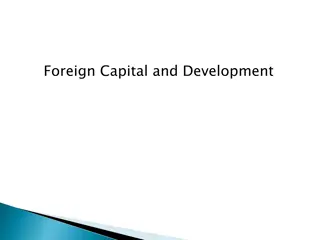
Full Info 1 Foreign Direct Investment Surge
India, the worldu2019s largest democracy with a rich cultural heritage, has undergone a dramatic economic transformation. From taking 67 years to achieve a $1 trillion economy, it reached $2 trillion in just 8 years and surpassed $3 trillion in slig
Download Presentation

Please find below an Image/Link to download the presentation.
The content on the website is provided AS IS for your information and personal use only. It may not be sold, licensed, or shared on other websites without obtaining consent from the author. Download presentation by click this link. If you encounter any issues during the download, it is possible that the publisher has removed the file from their server.
E N D
Presentation Transcript
Foreign Direct Investment Surge: Unprecedented Transformation Introduction India, the world s largest democracy with a rich cultural heritage, has undergone a dramatic economic transformation. From taking 67 years to achieve a $1 trillion economy, it reached $2 trillion in just 8 years and surpassed $3 trillion in slightly over 4 years. This rapid growth reflects a significant "Foreign Direct Investment Surge: Unprecedented Transformation" that has been pivotal in shaping the modern Indian economy. Economic Changes in India Recent economic developments have substantially impacted India s growth trajectory: Real GDP Growth: India's economy has expanded at a pace that surpasses nations like Russia, Italy, and Brazil. Middle-Class Expansion: The middle class, which comprised 31% of the population in 2021, is expected to grow to around 60% by 2047. Financial Inclusion: Enhanced access to banking services has enabled efficient fiscal subsidies through direct transfers. The Unified Payments Interface (UPI) supports approximately 10.24 billion transactions annually. Technology Infrastructure:India s open technology platform promotes interoperability and reduces reliance on single technology stacks. Domestic Demand: With two-thirds of GDP driven by domestic consumption, India's economic activity frequently exceeds supply. Impact of FDI on the Economy The "Foreign Direct Investment Surge: Unprecedented Transformation" has played a crucial role in India's economic development. Since independence, India has attracted $950 billion in FDI, with over 50% of this inflow occurring in the last 90 months. This investment, flowing from 162 countries across 61 sectors, predominantly utilizes the automatic route. Key sectors open to FDI include: Agriculture and Animal Husbandry Infrastructure Manufacturing Mining and Exploration E-commerce (Marketplace Model) Pharmaceuticals (Greenfield Projects) However, certain sectors like atomic energy, lottery businesses, chit funds, gambling, and real estate (except specific development projects) remain restricted. Effects of FDI on Real Estate
1.Property Value Increase: The influx of foreign capital often leads to higher property values, especially in major cities and luxury markets. Average property values are around 7500 per square foot. 2.Economic Impact: Increased construction activity due to FDI generates jobs and stimulates the local economy. Higher property tax revenues enhance government spending capabilities, with India s gross tax revenue rising by 10.4% to 27.58 trillion in 2023. 3.Currency Flux: Fluctuations in exchange rates can influence the attractiveness of investment, with favorable rates potentially drawing more foreign investors. 4.Market Stabilization: FDI helps stabilize markets by diversifying the investor base and reducing dependence on local economic conditions. 5.Demographic Shifts: Foreign investment can affect neighborhood demographics, reflecting broader economic trends. Reasons for the FDI Surge 1.Skilled Labor Force: By 2047, India is projected to represent 21% of the global workforce. Rapid urbanization and a large pool of skilled labor, especially in IT, contribute to foreign remittances, estimated at $125 billion in 2023. 2.Government Reforms: Key reforms driving the "Foreign Direct Investment Surge: Unprecedented Transformation" include: oRERA (Real Estate Regulatory Authority): Established in 2016 to improve transparency and accountability in real estate. oFDI Norms: Allowing 100% FDI under automatic routes in construction projects and simplifying rules for affordable housing. oSmart Cities Mission and Housing for All: Initiatives aimed at enhancing urban infrastructure and housing. oREITs (Real Estate Investment Trusts): Facilitate large-scale investments in income-generating real estate through operational management, avoiding the need for resale. 3.Growing Markets: The luxury market alone is projected to grow by $85 billion by 2023, with notable expansions in sectors such as software, hardware, construction, services, trading, and telecommunications. Conclusion The "Foreign Direct Investment Surge: Unprecedented Transformation" has been a driving force behind India s economic evolution, highlighting its role as a dynamic global economic player. With an open economy and robust private sector engagement, India presents unparalleled opportunities for growth and continues to assert itself as a key player on the global stage.






















